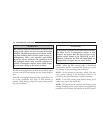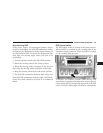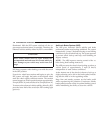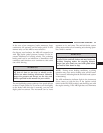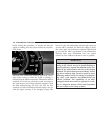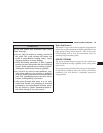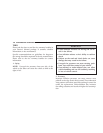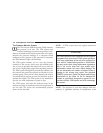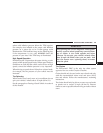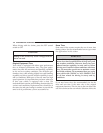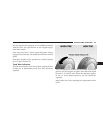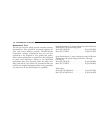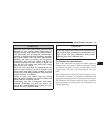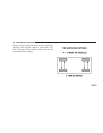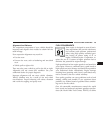
Tire Pressure Monitor System
The Tire Pressure Monitor System (TPM) monitors
the pressure in all tires. The TPM system uses
wireless technology to monitor tire pressure levels.
Sensors, mounted to each wheel as part of the valve stem,
transmit tire pressure readings to a computer which
monitors for low pressure. If low pressure is measured,
the TPM Indicator Light will illuminate.
The TPM system informs you of a low tire pressure
condition. If this occurs, correct your tire inflation pres-
sure as soon as possible, and inspect all of your tires. Be
sure to use a high quality gauge when adjusting pressure.
The TPM system is designed to periodically monitor your
tire pressure but cannot be expected to function as a tire
pressure gauge. There can be a delay between the instant
you adjust the air pressure in a tire and when the system
updates the display. The TPM system is not intended to
provide you with notification of rapid air loss.
The TPM system will cause the indicator lamp in the
instrument cluster to illuminate whenever the pressure in
one tire falls 25% below the recommended pressure
shown on the tire label.
NOTE:
A TPM system does not replace normal tire
maintenance.
CAUTION!
The TPM system has been optimized for the original
equipment tires and wheels. TPM system pressures
have been established for the tire size equipped on
your vehicle. Undesirable operation or sensor dam-
age may result when using replacement equipment
that is not of the same size, type, and/or style.
Aftermarket wheels can cause sensor damage. Do
not use aftermarket tire sealant or balance beads as
damage to the sensors may result. The standard
TIREFIT system (see Tirefit Tire Repair and Jacking
Instructions in the What To Do In Emergencies
section) is specifically designed to operate in con-
junction with the TPM system, and will not damage
the sensors.
NOTE:
The pressure in your tires changes with tem-
perature. A significant decrease in temperature could
142 STARTING AND OPERATING



